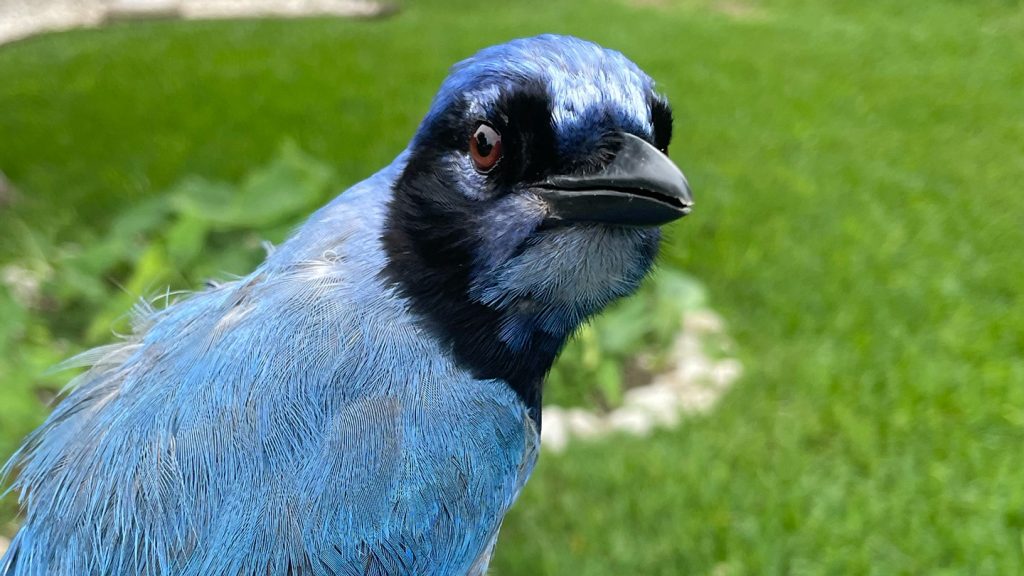The Surprising “Grue Jay”: A Rare Hybrid Born from Climate Change and Human Influence
In the bustling city of San Antonio in 2023, birdwatchers noticed something peculiar—a turquoise-colored songbird that didn’t quite fit any familiar species. This unusual avian visitor possessed the body and black-and-white tail bands reminiscent of a blue jay, but displayed the distinctive facial markings and unique rattling call of a green jay. Scientists have confirmed what many suspected: this remarkable bird is an extremely rare hybrid between two jay species that, until recently, rarely encountered each other in the wild.
Genetic testing revealed this “grue jay” (as some have affectionately dubbed it) has a green jay mother and a blue jay father. What makes this hybrid particularly remarkable is the evolutionary distance between its parents. Unlike most hybridizing species that share recent common ancestry, blue jays and green jays diverged at least 7 million years ago during the late Miocene Epoch—roughly the same timeframe when humans and chimpanzees last shared a common ancestor. Jamie Alfieri, an evolutionary biologist at the University of Iowa who studies speciation, emphasizes just how extraordinary this is: “The fact that two organisms, which have been evolving independently, came together to produce a viable offspring after 7 million years is amazing… It’s just a really long time.”
The convergence of these distantly related species represents a direct consequence of human-induced environmental changes. The green jay (Cyanocorax yncas), traditionally a tropical bird that until recently was found in the United States only in Texas’s Rio Grande Valley near the Mexican border, has been rapidly expanding northward. “And it happened quite quickly, maybe a 20-year period,” explains Timothy Keitt, an ecologist and evolutionary biologist at the University of Texas at Austin who led the research published in Ecology and Evolution. This northward expansion corresponds with warming climate conditions that have allowed the species to extend its range hundreds of kilometers beyond its historical boundaries. Simultaneously, blue jays (Cyanocitta cristata) have been pushing westward across North America, following human settlement patterns and thriving in suburban environments with their abundant food sources.
What prompted these two different jay species to mate remains something of a mystery. One possibility is simple novelty—birds are sometimes attracted to unusual characteristics in potential mates. Keitt notes research showing that unique song types can make certain birds more attractive to potential partners. A study from the University of Lancaster, for instance, found that male blue tits singing distinctive songs are more likely to hold female attention. Another explanation might be desperation—both parent birds could have been at the edges of their respective ranges, unable to find mates of their own species, and essentially settled for an interspecies relationship as a last resort.
While this hybrid offspring appears healthy, it faces social challenges that highlight the complexities of interspecies breeding. Though both blue jays and green jays are highly social birds that typically live in groups, observers noted the grue jay seemed to be alone. This isolation suggests that other blue jays in the area may have recognized its differences and excluded it from their social circles. Additionally, while this particular hybrid is male (and thus more likely to be fertile than a female hybrid would be), its reproductive future remains uncertain. The likelihood of finding a mate and producing offspring is complicated by its unique appearance and potential social rejection from both parent species.
Despite the fascinating nature of this rare hybrid, Keitt doesn’t expect blue and green jays to merge into a new species. Instead, this unusual bird serves as a living symbol of the rapid ecological transformations occurring due to human activities and climate change. As Keitt succinctly puts it: “So buckle in, folks. We’re going to see very different outcomes, lots of unusual weather and mixes of plants and animals we’ve never seen in the past.” The grue jay, with its blended features and uncertain future, reminds us that as humans reshape the planet’s climate and ecosystems, nature will respond in ways both unexpected and profound, creating new biological interactions that challenge our understanding of species boundaries and evolutionary processes.


